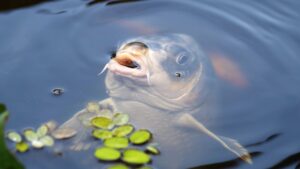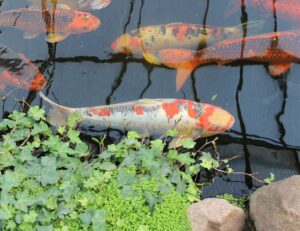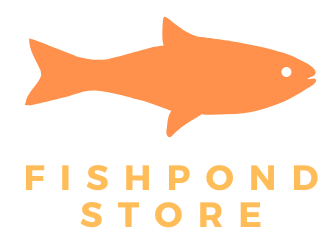Are you considering having a beautiful koi fish pond in your backyard, but are unsure about the ins and outs of koi fish care in your pond, and how to properly care for these graceful creatures? Look no further, as we are here to provide you with all the essential information you need to ensure the well-being of your koi fish.
From creating a suitable habitat to understanding their water requirements, we have got you covered. Join us as we explore the world of koi fish care and discover how to maintain a vibrant and thriving pond for these enchanting creatures.
Setting Up Your Koi Pond
Setting up a koi pond is an exciting venture that can provide you with endless hours of beauty and relaxation. To ensure your koi thrive and your pond remains a healthy environment, it’s important to follow a few key steps. First and foremost, choosing the right location for your pond is crucial.
You’ll want an area that receives a good amount of sunlight and is protected from strong winds. Next, determine the size of your pond based on the number of koi you plan to keep. Remember, koi require ample space to swim and grow. Once you have the location and size determined, it’s time to consider pond depth. Koi ponds should be at least three to four feet deep to provide the fish with enough room to move and to protect them from predators.
With the basics of your pond set up, it’s time to move on to installing a pond filtration system. This is vital for maintaining water quality and keeping your koi healthy. There are various filtration options available, such as biological filters and UV sterilizers, which help remove harmful substances and maintain water clarity.
Adding aquatic plants to your koi pond not only enhances its beauty but also assists in maintaining water quality. Plants oxygenate the water, absorb excess nutrients, and provide shade and shelter for the fish. Choose a variety of plants, such as water lilies and floating plants, to create a balanced ecosystem.
Water Quality Management
Maintaining proper water quality is a crucial aspect of koi fish care. One of the key components of water quality management is ensuring the pH level of the water is appropriate for koi. The ideal pH range for koi is between 7.0 and 8.5. Regularly testing the pH level and making adjustments as necessary is essential to keep your koi healthy.
In addition to pH, monitoring the temperature of the water is equally important. Koi thrive in temperatures between 59°F and 77°F, so investing in a reliable thermometer is a wise decision.
Regularly testing various water parameters, such as ammonia, nitrite, and nitrate levels, is crucial for maintaining optimal water quality. These tests should be conducted on a regular basis, especially during the initial stages of setting up your koi pond and after any significant water changes.
Adequate filtration plays a vital role in water quality management. It helps in removing impurities and maintaining a healthy environment for your koi. Investing in a high-quality filter system and performing regular maintenance and cleaning will go a long way in ensuring the well-being of your fish.
Performing regular water changes is another critical aspect of water quality management. These water changes help dilute any accumulated toxins and excess nutrients in the pond.
Generally, it is recommended to perform a 10-15% water change every week to maintain a stable and healthy environment for your koi. However, during hot summer months or if water quality issues arise, more frequent water changes may be necessary.

Feeding Your Koi Fish
Proper nutrition is essential for the health and vitality of your koi fish. Choosing a high-quality koi fish food is the first step in providing your fish with the necessary nutrients. Look for a food specifically formulated for koi that contains a balanced mix of proteins, fats, and carbohydrates. Additionally, consider the size of the pellets or flakes to ensure they are appropriate for the size of your koi.
Establishing a feeding schedule is important to maintain a consistent and healthy diet for your koi. Feed your fish two to three times a day, making sure to provide only what they can consume within five minutes.
Overfeeding can lead to poor water quality and obesity in your fish, so it’s crucial to avoid this common mistake. Monitoring your fish’s appetite is equally important. If you notice a decrease in appetite or weight loss, it may indicate a health issue, and adjustments to their diet or water conditions may be necessary.
To provide a well-rounded diet for your koi, consider adding variety to their meals. Supplement their staple food with treats such as freeze-dried or frozen shrimp, bloodworms, or even fruits like watermelon or oranges. Introducing these different foods not only adds nutritional value but also provides mental stimulation for your fish.
Maintaining Proper Pond Environment
Maintaining a clean and well-maintained pond environment is crucial for the health and well-being of your koi fish. Regularly removing debris, such as fallen leaves and excess algae, will help keep the water clean and prevent any potential issues.
Use a pond net or skimmer to remove debris from the surface of the water, and consider installing a pond vacuum for periodic deep cleaning.
Controlling algae growth is another important aspect of pond maintenance. Excessive algae can deplete oxygen levels and lead to poor water quality. To prevent algae growth, ensure a balance between sunlight and shade in your pond.
You can also introduce beneficial plants, like water lilies, that provide shade and help compete with algae for nutrients. It’s also essential to maintain a proper balance of beneficial bacteria in your pond, as they help to naturally control algae growth.
Parasites and diseases can pose a significant threat to the health of your koi fish. Regularly inspect your fish for any signs of illness or abnormal behavior. Early detection and treatment are crucial for the successful management of these issues.
Implementing a quarantine process for new koi before introducing them to the main pond can help prevent the spread of diseases. Additionally, consulting with a veterinarian who specializes in fish health can provide valuable guidance and support for managing fish health in your pond.
Oxygen levels in your pond are vital for the well-being of your koi fish. Ensure a sufficient oxygen supply by maintaining proper water circulation and aeration. This can be achieved through the use of water pumps, fountains, or waterfalls. Oxygenating plants, such as water hyacinths and hornworts, also provide additional oxygen during the daylight hours.

Managing Pond Temperature
As with any living creature, koi fish are sensitive to extreme temperature changes. Monitoring the water temperature in your pond is crucial to ensure the well-being of your fish. Invest in a reliable pond thermometer and regularly check the temperature, especially during seasonal transitions.
If the water temperature drops below the optimal range for koi, providing shade and shelter can help keep them comfortable. This can be achieved by adding floating plants, water features, or artificial shade structures to your pond.
During winter months, when temperatures drop significantly, it’s important to take additional steps to protect your koi. Using pond heaters or a de-icing system can help maintain a stable temperature and prevent the water from freezing completely.
Avoid sudden temperature changes, as this can stress your fish and compromise their immune system. Gradual changes in temperature are best for the overall health and well-being of your koi.
Handling Koi Fish
Proper fish handling techniques are essential to prevent stress or injury to your koi fish. When it becomes necessary to handle your koi for routine maintenance or health checks, it’s important to do so with care and gentleness.
Using a soft pond net or bowl is recommended for safely catching and transferring your fish. Avoid any rough handling or excessive pressure on their delicate body.
Minimizing stress is crucial as stress can compromise the immune system of your fish and increase their susceptibility to disease. Try to limit the frequency and duration of handling, and provide a calm environment during these instances.
Overcrowding your pond can also lead to increased stress, so it’s important to ensure you have an appropriate number of fish for the size of your pond.
Preventing Predators
Predators can pose a significant threat to the safety and well-being of your koi fish. To protect them from potential predators, consider installing a pond netting system. This will create a physical barrier, preventing larger animals like birds or raccoons from accessing your fish.
Additionally, using decoys or scare devices can help deter predators from approaching your pond. Providing hiding spots, such as caves or aquatic plants, will give your fish a safe place to retreat and hide from potential threats.
Regularly monitoring your pond for any signs of predators is important. Keep an eye out for tracks or disturbances around the pond area. If you do spot a potential predator, take immediate action to remove or deter it from your pond. By staying vigilant and proactive, you can create a safe environment for your koi fish to thrive.

Controlling Pond Plants
Aquatic plants can greatly enhance the aesthetic appeal of your koi pond, but proper maintenance is necessary to prevent the overgrowth of plants. Pruning and trimming your plants regularly will help control their size and prevent them from overshadowing your koi. Remove any excessive plant growth to maintain a balanced ecosystem and ensure your fish have ample space to swim.
Preventing the growth of invasive plant species is essential to maintain the health of your pond. Some plants, if left unchecked, can quickly take over and disrupt the balance of your pond’s ecosystem.
Regularly inspect your pond for any invasive species and take appropriate action to remove them. Using biological control methods, such as introducing natural predators or herbivorous fish, can also help control excessive plant growth.
*Remember, if your plants are not potted or certainly secured, the Koi Fish will definitely uproot them! (I learned that from experience.)
Managing Fish Health
Monitoring the behavior and health of your koi fish is essential to catch any potential issues early on. Regularly observe your fish for any signs of abnormal behavior or physical changes.
Common signs of illness can include lethargy, loss of appetite, visible sores or lesions, and changes in swimming patterns. If you notice any of these signs, it’s important to take prompt action.
Treat any health issues promptly by consulting with a veterinarian who specializes in fish health. They can provide guidance on appropriate treatment options and help you address any underlying causes of illness.
Quarantining new fish before introducing them into your main pond is another important step in managing fish health. This allows you to monitor their condition and prevent the potential spread of diseases to your existing fish population.
Enjoying the Koi Fish Pond
Once you have taken all the necessary steps to set up and properly maintain your koi pond, it’s time to sit back and enjoy the beauty and tranquility it brings. Take the time to observe and appreciate your koi fish as they gracefully swim through the water.
Creating a relaxing atmosphere around your pond with comfortable seating and soothing landscaping can further enhance the experience.
Consider hosting koi fish viewing events for family and friends. This allows you to share the joy of your pond and educate others about the beauty and care of koi fish. Taking photographs or videos of your koi can also be a rewarding way to capture and share the unique features and personalities of your fish.
Participating in koi shows can be an exciting opportunity to showcase your beautiful fish and learn from experienced enthusiasts. These events provide a chance to meet other koi enthusiasts, exchange knowledge, and appreciate the art of koi keeping.

Koi Fish Care In Your Pond
In conclusion, proper care and maintenance are essential for creating a thriving and healthy koi pond. By following these guidelines, you can ensure the well-being of your koi fish and enjoy the beauty and tranquility they bring to your outdoor space.
We hope this helped and you have a better understanding about Koi Carp. They are beautiful fish to own and look after, and after a while can become quite friendly to those that feed them. I have personally kept Koi for many years, and they never cease to fascinate me. Remember one thing though, so small Koi you buy will grow in huge fish over the years, make sure your pond is big enough! Take a look at ‘Is It Hard To Maintain A Fish Pond‘, which will provide additional information about your actual pond.
